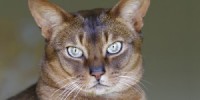Portraits: Lachesis
When we think of snakes we often get a bad idea about the types of animals and conditions that may respond to or need a snake medicine.
My experience with the small animals I have treated with lachesis are a little surprising at first glance as they are not the classic aggressive or savage animals that are so often associated with this medicine. They do, however, all share some similarity in their demeanour that I will endeavour to impart.
Lachesis belongs to the Crotalidae, a snake family that includes the pit-vipers, rattlesnakes, lanceheads, moccasins and copperheads, which are the vipers of the New World, the Americas. In Classical Mythology, Lachesis is the Fate who determines the length of the thread of life.
Many animals that have responded to lachesis in my practice have been quite nice and have had a power about them that has not resorted to savagery or attack. In fact, if you think about the amount of energy a snake requires to manufacture venom, it is unlikely that they would want to waste it unless necessary for survival.
Urine spraying in cats can be an act of aggression and the first and most memorable case of the effectiveness of lachesis was a case of a young male Birman cat that I was asked to see because a veterinary surgeon wanted to amputate his pinna to prevent a mast cell cancer from spreading or growing.
This handsome cat sat high on furniture and looked at you in a calculating and imperious but non threatening manner. He was very secure in himself and knew how to manipulate his owners. They even said to me that they wouldn’t be surprised if he got cancer just to get more attention. Contrary to what we may have developed as a picture of lachesis, this cat was big but not enormous, nor black nor aggressive but his power was evident. His animal nature was expressed by urine spraying in front of the owners to get his own way in a defiant and desperate gesture as he was confined to the house. Lachesis is tubercular and will not stand confinement. Urine spraying in desexed cats is also a sexual outlet.
Cancer has themes of rebellion against confinement or restraint as have the snake medicines. It is also increasingly apparent that immune mediated diseases respond to snake medicines and I use lachesis quite often for cancers like mast cells and allergies if other parameters ring true. I also think cats are snakes with fur until proven otherwise. This cat’s ear was saved, cancer disappeared and he used lachesis effectively, whenever he needed, to curb his spraying on and off for a year until he was permitted outside in a new house.
Another case I only saw once as a new homeopath and it surprised me as well.
Maybe the element of surprise is also snake! A small older farm terrier came to see me for a seasonal respiratory allergy that had been recurring for years. I recall as I was examining this little dog and looking for clues that it was especially reactive in a stilled, silent and strong manner when I was palpating its throat area. Lachesis sprang to my entirely open mind and was reaffirmed by the Spring onset and the allergy theme. A single dose of lachesis cured this dog, with no recurrence, after years of allopathic attempts.
Some cases have taken a little longer to arrive at lachesis but with no less success. I treated an old Golden Retriever with seriously bleeding nasal polyps with lachesis after trying many other medicines including phosphorus which is directly related to snake venoms. The keynote for the eventual prescription in this dog was his jealousy and the effectiveness of lachesis once again surprised me as he was not a big, black savage dog by any means. After many years of entrenched behaviour that was considered normal, he also became more open and friendly with the other dog in the household as well as living comfortably with reduced and non bleeding polyps. Perhaps this is not considered a cure but was certainly a life saving intervention in this resilient old dog.
I have long regarded lachesis as the cleverest medicine in our repertory. All the animals I have successfully treated with lachesis have been very clever and I could even say that they have a wry or wicked sense of humour. Loquacity is an unreliable rubric in my cases; except in my talkative teenage son who has used lachesis effectively for Spring onset asthma. Perhaps the dog equivalent, rather than barking or licking, is a sneaky nip that requires mental planning to execute with accuracy. This brings to mind our heel nipping Queensland Blues and other cattle or stock herding dogs that can be extremely clever.
On repertorisation I sometimes find it difficult to differentiate between lycopodium and lachesis which may seem an unusual choice given their differences of source. They both have salivation, can be base or nasty (bully), arrogant, spiteful, worse in the morning or waking and actually complement each other quite well according to Kent. I wonder whether lycopodium is the plant version of the Supreme’s curse cast upon snakes, whereby they must go without legs upon the earth as lycopodium was also cast down to be a lowly club moss from a once enormous, prehistoric tree.
Case summary notes or ‘guess the remedy’ for lachesis animals so far would read as, clever, powerful, funny, manipulative, admirable, resilient, allergies and immune mediated diseases, Spring, cancer, throat, head, neck, tubercular, generally phosphorus responsive if bleeders and occasionally aggressive.
All good fun really unless you get bitten.



July 11th, 2019 at 5:52 pm
That cat’s expression looks just like my dog. I fell in love with her as a puppy when someone was carrying her down the street and she looked down her nose at us. She’s a Doberman/Ridgeback/Lab mix. She’s 12 now and I just discovered a growth on the roof of her mouth directly below where she had an intranasal kennel cough vaccine 5 months ago. The boarding kennel requires it – which I’m starting to think is criminal. The homeopathic vet felt sure Lachesis was her remedy and she is a nipper/striker ‘stay back’ anxious dog. After her first dose of 6c, she fell asleep immediately and on her walk the next day she didn’t frown, scowl or react to any stimuli at all – a first. I have high hopes this will reduce the growth. Thanks for this awesome portrait.
June 9th, 2014 at 7:30 am
An excellent portrait of Lachesis. The human picture is also a very vivacious,intelligent one but they do have secretiveness with surprise attacks in them!